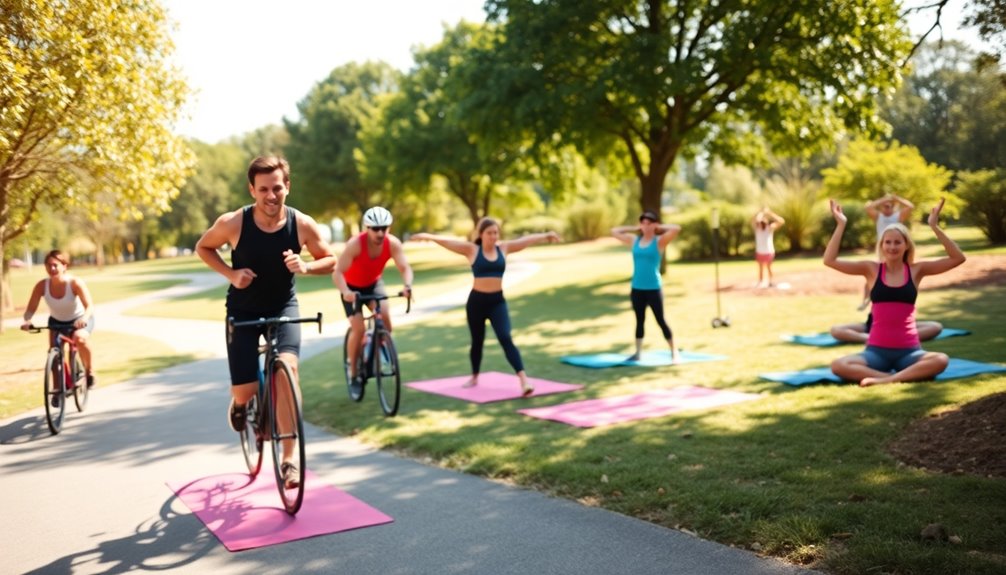To balance running with other forms of exercise, mix in strength training, cross-training, and rest days to manage total training load and prevent injury. Listen to your body; if you feel sore or fatigued, adjust your schedule accordingly. Incorporating low-impact activities like swimming or cycling can aid recovery while enhancing your overall performance. This diverse approach keeps workouts enjoyable and effective. There's plenty more to explore about optimizing your routine for peak performance.
Key Takeaways
- Incorporate cross-training, like swimming or cycling, to enhance recovery and prevent injuries while improving overall running performance.
- Schedule rest days between intense workouts to allow muscles to recover and reduce the risk of overuse injuries.
- Mix workouts with strength training and flexibility exercises to improve muscular balance, stability, and overall fitness.
- Listen to your body; adjust your schedule based on signs of fatigue or soreness to optimize performance and prevent overtraining.
- Engage with a supportive community for motivation, accountability, and access to diverse training resources and techniques.
Why Total Training Load Matters

When you consider your training routine, understanding total training load is important for maintaining your performance and preventing injuries. Total training load includes all physical activities you perform over time, impacting your recovery needs and risk of overtraining.
High-intensity running sessions and long runs can greatly elevate your total training load, making careful planning critical. Coaches often design training plans with distinct blocks and recovery weeks, allowing you to manage total training load effectively.
Insufficient recovery periods between sessions can lead to overuse injuries, as most running injuries arise from inadequate rest. Remember, your individual fitness level and genetic factors also dictate how much training load you can handle, so personalizing your training program is essential for best results. Additionally, incorporating self-love practices into your routine can enhance your overall well-being and support your training goals.
How Training Goals Impact Your Schedule

Understanding your total training load sets the stage for how training goals impact your schedule. Your training schedule should align with your specific goals, whether it's improving endurance or building strength.
When planning your week, be strategic about incorporating strength training sessions, as doing them too close to running can hinder strength gains. Always listen to your body; if you're feeling fatigued or sore, adjust your weekly schedule accordingly.
Flexibility is key—modify your plan based on how you feel, ensuring you don't overdo it. This adaptive approach not only maximizes the benefits of both running and strength training but also keeps you injury-free and on track to meet your fitness objectives. Additionally, maintaining strong communication skills during training discussions can enhance your overall understanding and execution of your fitness plan.
Allow Enough Recovery Time

You need to pay attention to your body's signals to avoid overtraining.
Scheduling regular rest days is key, as it gives your muscles time to recover and rebuild.
Listen to any signs of fatigue or soreness; they're your body's way of telling you to take it easy. Additionally, proper nutrition is essential for muscle recovery and overall physical performance.
Recognizing Fatigue Signals
Recognizing fatigue signals is essential for maintaining your fitness routine and preventing overtraining.
When you listen to your body, you can adjust your workouts effectively. Here are some key signals to watch for:
- Persistent soreness that doesn't fade after a few days
- Increased irritability or lack of motivation
- Difficulty completing workouts at your usual intensity
- Delayed onset muscle soreness (DOMS) peaking 48 hours post-exercise. Additionally, being aware of narcissistic behaviors can help you understand how external stressors may impact your motivation and overall well-being.
Scheduling Rest Days
While it might be tempting to push through workouts without breaks, scheduling rest days is essential for your body's recovery and overall performance. These days allow your muscles to rebuild and strengthen, helping to prevent overuse injuries. It's important to space high-intensity running sessions at least 24 hours apart from leg strength workouts to guarantee proper recovery. Keep in mind that delayed onset muscle soreness (DOMS) peaks around 48 hours post-exercise, so strategically placing rest days accommodates this recovery window. Training the same muscle groups on consecutive days can lead to fatigue and injury risk, making rest days critical in your training schedule. Additionally, understanding the importance of emotional expression can help you manage stress levels during your training regimen.
Know Your Body

Understanding your body's signals is essential for balancing running with other exercises. To maximize your performance and prevent injuries, you must know your body and recognize when you need to adjust your training.
Here are some key points to evaluate:
- Listen to your body; signs of fatigue or soreness mean it's time for easier training days.
- Incorporate strength training while allowing adequate recovery periods, ideally 24 hours between high-intensity runs and leg workouts.
- Be aware that delayed onset muscle soreness (DOMS) peaks around 48 hours, affecting your next workout.
- Adjust your schedule based on both physical and mental states to enhance overall effectiveness.
- Consider incorporating gentle stretching to further aid recovery and improve flexibility.
Benefits of Cross-Training for Runners

Cross-training offers you a chance to prevent injuries by balancing the demands on your body.
By engaging in different exercises, you not only enhance muscle balance but also improve your overall running performance.
Incorporating these strategies can keep your training fresh and effective, helping you reach your goals. Additionally, exercises like hula hooping for weight loss can provide a fun way to improve cardiovascular fitness while engaging your core muscles.
Injury Prevention Strategies
Incorporating a variety of exercises into your running routine can greatly reduce the risk of injuries.
Cross-training allows different muscle groups to recover while maintaining overall fitness. Here are some effective injury prevention strategies:
- Engage in low-impact activities like swimming or cycling for active recovery.
- Include strength training to enhance muscular balance and stability.
- Try plyometrics or stair climbing to improve strength and coordination.
- Mix running with other forms of exercise to prevent burnout.
- Additionally, incorporating efficient heating solutions can create a more comfortable environment for recovery after workouts.
Enhanced Muscle Balance
Runners often focus solely on their sport, but mixing in different exercises can greatly enhance muscle balance. By incorporating cross-training activities like swimming and cycling, you target different muscle groups, reducing the repetitive strain that comes with running and strength training alone. This approach not only builds strength but also helps prevent overuse injuries. Additionally, regular exercise can help prevent obesity and related health issues, contributing to overall well-being.
| Benefit | Description |
|---|---|
| Enhanced Muscle Balance | Strengthens underused muscle groups |
| Injury Prevention | Reduces risk of overuse injuries |
| Improved Endurance | Boosts muscle endurance and power |
| Variety in Workouts | Prevents burnout and keeps you engaged |
| Long-term Adherence | Encourages consistent fitness routines |
Mixing it up leads to sustainable running and improved overall health.
Improved Overall Performance
When you mix different fitness activities into your routine, you'll likely see significant improvements in your overall running performance. Cross-training boosts strength and endurance, which is essential for injury prevention.
By engaging in varied workouts, you can target different muscle groups, resulting in:
- Enhanced aerobic fitness through swimming or cycling.
- Improved strength and speed with plyometrics.
- Faster recovery from muscle tightness and soreness.
- Reduced risk of burnout by keeping your training enjoyable.
These benefits not only help you run more efficiently but also guarantee you stay consistent without overtraining. Additionally, maintaining high vibrational energy through diverse exercises can further enhance your athletic mindset and performance.
Scheduling Tips for Mixing Running, Gym, and Other Activities

To effectively mix running with gym sessions and other activities, prioritize your running days by scheduling them consistently each week.
Alternate your running days with strength training or other exercises to create a balance between running and overall fitness. This approach allows for adequate recovery and keeps your fitness level on track.
Don't forget to incorporate rest days between intense workouts to optimize recovery and prevent injuries. Keep your schedule flexible, adjusting based on how your body feels and your overall workload.
Mixing workouts, like adding yoga or cross-training, keeps things interesting and helps you avoid burnout.
Avoiding Overtraining: Signs You're Doing Too Much

Overtraining can sneak up on you, especially when you're juggling running with other intense workouts.
It's essential to recognize the signs that indicate you might be doing too much. Pay attention to these indicators:
- Persistent soreness and fatigue that doesn't fade after rest
- Increased irritability and mood swings affecting performance
- Consistently feeling drained, both physically and mentally
- A plateau or decline in your training cycle performance
If you notice these symptoms, it's time to prioritize recovery.
Adjust your workout intensity and frequency to allow your body the rest it needs.
Sample Weekly Routine for Runners Who Strength Train

Creating a balanced weekly routine is essential for runners who also engage in strength training, as it helps maximize performance while minimizing the risk of injury.
Start with three running days: one easy run, one speed or tempo workout, and one long run. On a designated strength training day, focus on full-body exercises like squats, lunges, and deadlifts to enhance your running performance.
Schedule two recovery days, incorporating active recovery like light yoga or walking to promote flexibility and aid muscle recovery.
Verify you have at least 48 hours of recovery between high-intensity running sessions and leg workouts to avoid delayed onset muscle soreness (DOMS).
This routine allows you to build strength while maintaining your running endurance.
Ready to Run Stronger?

If you're looking to elevate your running game, connecting with a community can make a significant difference.
Being part of a supportive group not only enhances your training but also fosters a sense of camaraderie.
Here are some ways a community can help you run stronger:
- Gain valuable tips and motivation from experienced runners.
- Access resources on best practices and new training techniques.
- Stay accountable through events and online platforms.
- Keep your training fresh with updates on community activities.
Frequently Asked Questions
What Exercise Should I Combine With Running?
You should combine running with strength training exercises like squats and lunges to build muscle endurance and stability.
Adding cross-training activities, such as swimming or cycling, can keep your aerobic fitness high while engaging different muscle groups.
Incorporating yoga or mobility exercises will enhance your flexibility and balance, essential for maintaining proper form.
Finally, don't forget recovery activities like walking or light stretching to help your muscles recover and prevent injuries.
How to Balance Running With Other Sports?
How do you juggle running with other sports? Think of your body as a finely-tuned orchestra; each sport plays an essential part in harmony.
Schedule your runs on alternate days to allow recovery and prevent injuries. Mix in low-impact activities like swimming or cycling to target different muscles.
Don't forget to incorporate strength training for legs and core on non-running days. Listen to your body and adjust as needed for a balanced, effective routine.
What Is the 80% Rule in Running?
The 80% rule in running suggests that you should spend about 80% of your training time at low intensity.
This approach helps you build endurance and recover effectively. The remaining 20% of your training can be at higher intensities to improve speed and performance.
How to Balance Running and Working Out?
To balance running and working out, start by scheduling your runs consistently.
Incorporate strength training on non-running days to avoid fatigue and injury. Aim for one quality speed run and a long run each week while cutting out unnecessary miles.
Don't forget to include at least one rest day to let your muscles recover.
Consider cross-training like swimming or cycling to maintain fitness while reducing impact on your joints.
This way, you'll enhance your overall performance.
Conclusion
Balancing running with other forms of exercise can truly elevate your performance and overall fitness. Did you know that runners who incorporate strength training can improve their running economy by up to 8%? By mixing workouts, allowing recovery, and listening to your body, you'll not only avoid overtraining but also enhance your endurance. So, take charge of your training load, embrace cross-training, and get ready to run stronger than ever!









